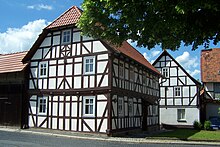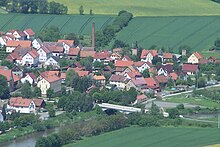Big boy
|
Big boy
City of Treffurt
Coordinates: 51 ° 8 ′ 11 ″ N , 10 ° 10 ′ 30 ″ E
|
|
|---|---|
| Height : | 181 (170-200) m |
| Area : | 12.41 km² |
| Residents : | 1316 (1992) |
| Population density : | 106 inhabitants / km² |
| Incorporation : | March 8, 1994 |
| Postal code : | 99830 |
| Area code : | 036923 |
|
Big boy
|
|
|
View of Großburschla
|
|
Großburschla has been part of the city of Treffurt in the Wartburg district in Thuringia since 1994 .
geography
Großburschla is located in the Werra valley , in the far northwest of the Wartburg district in Thuringia. The locality is about 90% territorially enclosed by Hessian territory, the total area of the district is 12.41 km².
mountains
The highest elevations are the Heldrastein with the pulpit ( 503.8 m above sea level ) and the Dreiherrenstein ( 488.5 m above sea level ).
Waters
Großburschla is located on the banks of the Werra , in the local area the Elderunderbach flows into it as a left tributary ; on its way through the district it takes in the Rambach , the Weißenborner Bach and several unnamed source streams. In this stretch of water, the Werra is classified as another federal inland waterway .
geology
Großburschla is located in the wide floodplain of the Werra with mighty gravel deposits. The river cuts through the layers of red sandstone (outcrop below the Pfalzburg ). For several centuries, weathered red sandstone formed the basis for the commercial mining of house litter in the Auf der See field on the Rambach border; as in Walldorf , cave-like mining tunnels were created.
The steep slopes of the Heldrastein and the neighboring Mainz heads are impressive examples of shell limestone .
Neighboring places
Großburschla is bordered by the Hessian towns of Weißenborn with the Rambach district, the Wanfrieder districts of Völkershausen, Altenburschla and Heldra (with the former Großburschla train station ), the Treffurter districts of Schnellmannshausen and Ifta .
history
First mention
Großburschla was mentioned for the first time in 860 in a deed of donation from Count Erpho to the Würzburg monastery; it was named brustlohum . The next notarization in 876 confirmed the transfer of the tithe to the Fulda monastery by King Ludwig the German .
middle Ages
The place belonged to the dominion of the Lords of Treffurt since the Middle Ages . Old connecting paths led below the Pfalzburg over the Sandberg to Treffurt and Schnellmannshausen, a Werrafurt led past the monastery to the neighboring towns of Heldra and Altenburschla and again to Treffurt. With the disempowerment of the knights, the town of Großburschla also became part of the Treffurt estate . The village was divided into three equal parts and received a mayor for each district.
On February 13, 1525, 1000 rebel farmers gathered in the Treffurt area. They also looted and devastated the monastery property in Großburschla. A few years later the Reformation was introduced in the Hessian and Saxon districts, the Mainz part remained Catholic, this was possible because there was also the church of St. Nikolai in the village in addition to the collegiate church.
A wooden bridge was built as early as the 18th century. An important transport was also the Werra itself, in the Großburschlaer Töpfergasse numerous workshops produced the coveted in the 17th century Werra ceramic .
19th century
Thanks to its climatically protected location in the Werra Valley, Großburschla was a relatively wealthy, agricultural place. In addition to vegetables and ornamental plants, tobacco was also grown with great success. The place supplied numerous tobacco factories in the surrounding area until the 1960s. The cultivation of cherries also became important. So-called criminals - a group of gypsies who had settled in big boys - operated a flourishing trade in scouring sand .
20th century
In 1902 Großburschla received a train station on the Schwebda – Wartha railway line , which connected the place with Eisenach , Mihla , Creuzburg , Treffurt , Wanfried and Eschwege . The economic development favored by this led to the construction of a brick factory and a chair factory. In the 1920s, Großburschla and the nearby Heldrastein became a popular excursion destination.
During the division of Germany after 1945, the Thuringian big boy protruded like a topographical finger about 7 km into Hesse (similar to its neighboring Heldra to Thuringia) and was therefore completely in the border area of the GDR , which was only used by residents and People with special permission were allowed to enter. All traffic routes to Hesse were interrupted after the only connection through the "bottleneck" (narrowest point 900 meters, but only a few meters parallel to the border) was built in 1952 from Schnellmannshausen over the Heldrastein. Since the Großburschla train station was in the Heldra district and thus just under but completely on Hessian territory, access to the railway network was completely interrupted with the establishment of the inner-German border .
The situation only eased from November 1989 when, in the course of the reunification of Germany, the road and path connections to neighboring Hessian towns were gradually opened again. In 1994 Großburschla was incorporated into the city of Treffurt.
Culture and sights
Church of St. Boniface
The village church of St. Bonifatius is an originally Romanesque basilica, which was rebuilt after being destroyed and has been preserved in fragments. Regardless of this, it is one of the most valuable architectural monuments in the region.
Hero stone
Above Großburschla is the Heldrastein with the Dreiherrenstein , the Hüneburg , the remains of the Henningshöhle , a nature trail and the tower of the unit .
Green Belt and Werra Valley Cycle Path
Großburschla is located on the Werra Valley cycle path in the section Treffurt – Wanfried. Hiking trails and viewpoints were created on the former border strip as part of the Green Belt Germany project . At Heldra, a disused river barrier as a steel lattice bridge enables the Werra to be crossed.
traffic
Road traffic
Großburschla is on country roads L: 2110 (via Heldra / Großburschla station) and L 2109 (via Schnellmannshausen) to the B 250 connected. The B 7 can be reached via the L 1019 and the neighboring towns of Weißenborn and Röhrda in Hesse . The next motorway junction is the Eisenach-West junction of the A 4 .
Rail transport
The operation of the Werra Valley Railway on the Schwebda – Großburschla – Treffurt – Wartha line was interrupted with the division of Germany and discontinued in sections from 1945–1994. The Großburschla train station was already in Heldra in Hesse . The nearest train stations are now in Eschwege , Mühlhausen / Thuringia and Eisenach .
Transportation
Großburschla is connected by the following bus lines operated by the Wartburgmobil transport company and the Werra-Meißner local transport service:
| line | Driving distance |
|---|---|
| 170 | Eisenach - Creuzburg - Ifta - Schnellmannshausen - Treffurt - Großburschla - Wanfried - Eschwege |
| 172 | Großburschla - Heldra - Wendehausen - Treffurt - Falken |
| 232 | Treffurt –Großburschla– Wanfried - Eschwege |
Personalities
- Walter Eichenberg (* 1922 in Großburschla; † 2018 in Leipzig), composer, trumpeter, conductor and arranger
literature
- Interest group Heldrastein (editor): Der Heldrastein , Ringgau-Datterode 1997 ISBN 3-930342-06-5 , approx. 300 pages
Individual evidence
- ↑ Thuringian Ordinance on the dissolution of the Großburschla community and its incorporation into the city of Treffurt from February 16, 1994 (GVBl p. 247)
- ↑ Thuringian State Surveying Office TK25 - sheet 4827 - Treffurt
- ^ Directory of other federal inland waterways, published in Directory E, serial no. 62 and directory F der Chronik ( Memento of the original of July 22, 2016 in the Internet Archive ) Info: The archive link has been inserted automatically and has not yet been checked. Please check the original and archive link according to the instructions and then remove this notice. , Federal Waterways and Shipping Administration
- ↑ a b Kurt Mötzing The sandstone caves under the Heldrastein In: Das Werraland , Heft 2, Eschwege, 1968, pp. 62–64
- ^ Geyer, Jahne, Storch Geological sights of the Wartburg district and the independent city of Eisenach In: Naturschutz im Wartburgkreis , issue 8, Bad Salzungen 1999, p. 25f
- ↑ Thuringia road network map as of April 2011 at www.thueringen.de, accessed on May 17, 2011
Web links
- Homepage about Großburschla ( Memento from December 22, 2014 in the Internet Archive )










